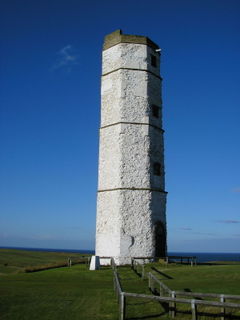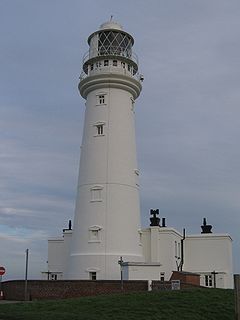- Flamborough Head
-
Flamborough Head is a promontory of 8 miles (13 km) on the Yorkshire coast of England, between the Filey and Bridlington bays of the North Sea. It is a chalk headland, and the resistance it offers to coastal erosion may be contrasted with the low coast of Holderness to the south. There are larger numbers and a wider range of cave habitats at Flamborough than at any other chalk site in Britain, the largest of which are known to extend for more than 50 m from their entrance on the coast. Flamborough Head was featured on the television programme Seven Natural Wonders as one of the wonders of Yorkshire and briefly in the first series of Coast
Contents
Flamborough Head Lighthouse
The Flamborough Head Lighthouse has 4 white flashes every 15 seconds. Trinity House operates tours of the lighthouse seasonally.
Special Area of Conservation
Flamborough Head has been designated a Special Area of Conservation (SAC) by the British Government's Joint Nature Conservation Committee (JNCC). (Special Areas of Conservation are strictly protected sites designated under the European Community Habitats Directive, which requires the establishment of a European network of important high-quality conservation sites in order to make a significant contribution to conserving the 189 habitat types and 788 species identified in Annexes to this Directive.) Flamborough Outer Headland is an 83 hectare (210 acres) Local Nature Reserve[1]
Birds
Seabirds such as Northern Gannets and Atlantic Puffins breed abundantly[citation needed] on the cliffs, and nearby Bempton Cliffs has an RSPB reserve.[2] The shooting of seabirds at Flamborough Head was condemned by Professor Alfred Newton in his 1868 speech to the British Association for the Advancement of Science. Local MP Christopher Sykes introduced the Sea Birds Preservation Act 1869, the first Act to protect wild birds in the United Kingdom.[3]
Because it projects into the sea, Flamborough Head attracts many migrant birds in autumn, and also has a key point for observing passing seabirds. When the wind is in the east, many birders watch for seabirds from below the lighthouse, or later in the autumn comb the hedges and valleys for landbird migrants. Flamborough Head also has a bird observatory.
Battle of Flamborough Head 1779
A Franco-American squadron fought the Battle of Flamborough Head with a pair of Royal Navy frigates in the American Revolutionary War on 23 September 1779. In the engagement, USS Bonhomme Richard and Pallas, with USS Alliance, captured HMS Serapis and Countess of Scarborough, the best-known incident of Capt. John Paul Jones's naval career. The toposcope at the lighthouse commemorates the 180th anniversary of the battle.
 North landing, Flamborough Head, c. 1880. Photo National Maritime Museum, ID: G2381
North landing, Flamborough Head, c. 1880. Photo National Maritime Museum, ID: G2381
Danes Dyke
Danes Dyke is a 2-mile (3-km) long ditch that runs north and south isolating the seaward 5 square miles (13 km2) of the headland. The dyke and the steep cliffs make the enclosed territory and its two boat launching beaches, North and South Landings, easily defended. Despite its name, the dyke is prehistoric in origin, and Bronze Age arrowheads were found when it was excavated by Major-General Augustus Pitt-Rivers in 1879.
In fiction
Flamborough Head and the village of Flamborough were also the setting for the book Bill Takes the Helm (Betty Bowen, published 1955 by Burke Publishing Company, London, England). Summarised, this is about an American boy's fight to save his grandmother's house – in which he, his sister and grandmother are living – from destruction by the sea. He is also desperately trying to get used to England after the death of his mother, who requested in her will that he be sent there.
Lightning strike
During the evening of 23 August 2006, a lightning bolt hit a buttress on the cliffs, sending 100 tonnes of rock into the sea.[4]
References
- ^ "Local Nature Reserves". Natural England. http://www.lnr.naturalengland.org.uk/Special/lnr/lnr_details.asp?C=22&N=&ID=781. Retrieved 3 February 2011.
- ^ The RSPB: Bempton Cliffs. Retrieved 16 October 2010
- ^ Barclay-Smith, Phyllis (1959): The British contribution to bird protection Ibis 101(1):pp. 115-122
- ^ Lightning strike damages cliffs
External links
Categories:- Geography of the East Riding of Yorkshire
- Headlands of England
- Sites of Special Scientific Interest in Humberside
- Special Areas of Conservation in England
- Lighthouse museums in England
- Lighthouses in England
- Museums in the East Riding of Yorkshire
Wikimedia Foundation. 2010.


